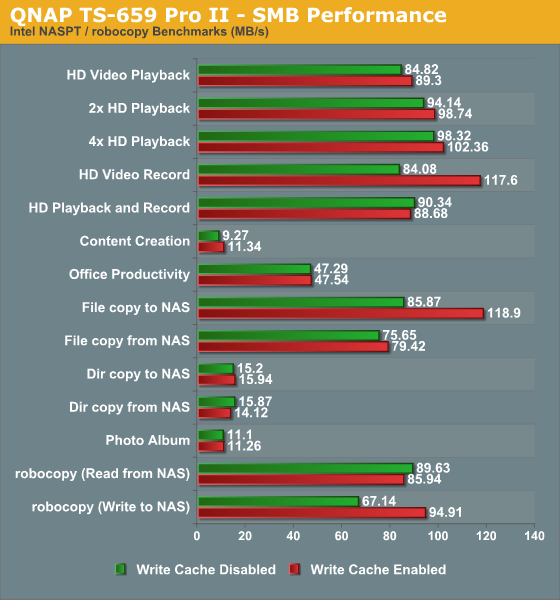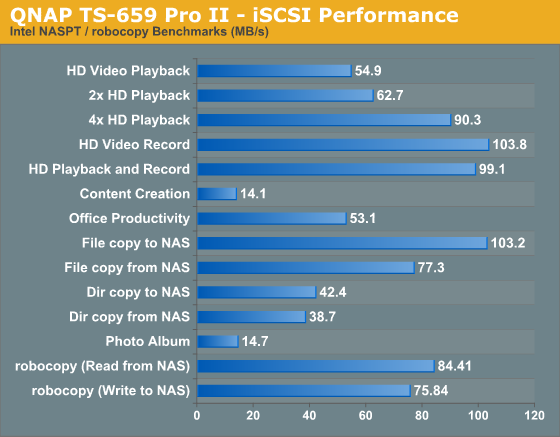QNAP TS-659 Pro II Review
by Ganesh T S on September 19, 2011 8:00 AM EST- Posted in
- IT Computing
- NAS
- QNAP
Samba shares can be set up easily by enabling the Microsoft Networking service. Under Access Rights Management, any of the folders in the NAS can be included in the 'Share Folders' section. Running the Intel NASPT benchmark and the robocopy tests gave us the following results:

Note that we have also run the benchmarks with the write cache enabled. This shows more than 35% improvement in the write intensive workloads, but the usual expected performance improvement is between 10 to 20% in general use. Unfortunately, it is recommended that the write cache be turned off for virtualized environments.
Moving on to iSCSI, it is again quite straightforward to enable the iSCSI service in the Disk Management's iSCSI subsection. The Target Management tab has a Quick Configuration Wizard to help create an iSCSI target and LUN.

In addition to the NASPT benchmarks for iSCSI, we also put the target through the HD Tune Pro benchmarks. The gallery below presents the various metrics of interest.
In order to test out NFS performance, we set up port trunking with 802.3ad for the ESA I340 in Ubuntu 11.04. rsync was used to replicate the robocopy command of transferring a 10.7 GB Blu-ray folder structure to the NAS and back from it.
| TS-659 Pro II NFS Performance in Ubuntu 11.04 | |
| Write to NAS | 67.83 MBps |
| Read from NAS | 61.30 MBps |
| . | |
















69 Comments
View All Comments
Toadster - Monday, September 19, 2011 - link
the specs on page #1 show 43W max power, but in the SMB, ISCSI and NFS page - you show 72.3W usage - which is it?also - why the heck are they using a 350W PSU when only 72.3W max? I could see maybe a 100W PSU which may remove the need for the PSU fan (thereby reducing noise?)
overall, very tempted to get this device!
ganeshts - Monday, September 19, 2011 - link
That spec on page #1 is QNAP's claims (and that is with 500 GB hard drives -- mentioned somewhere else). We measured 72.3W and stand by it :)Echo your sentiments on the PSU.. And QNAP claims 350 W PSU when the internal PSU is just 250W (not that it matters when the max power consumption is around 70 W only)
MichaelD - Monday, September 19, 2011 - link
It's sad that a state-of-the-art, $1K+, SMB NAS device still is unreliable when it comes to rebuilds. I stopped using my D-Link DNS-343 (not in the same class as the QNAP) because of all the issues I had with it. Dog slow access speeds, lockups, you name. FW flashes fixed nothing.Granted, the web interface is very attractive and it has a lot of high-end features (and the display is nice looking) but when it comes down to brass tacks, data integrity and availability are all that matters. If I can't rely on this device to successfully rebuild after a drive failure, what good is it?
I built my own NAS (server) out of a mATX mobo/RAM/CPU/HW RAID card I had laying around. I own a copy of Server 2003. I also owned the 5-drive SATA enclosure. Been up for almost 18 months now with a reboot roughly monthly for Windows updates. Zero issues.
These "shoebox NASs" just aren't ready for prime time. STILL.
saiga6360 - Monday, September 19, 2011 - link
Windows updates? LOLjimr1234567890 - Monday, September 19, 2011 - link
What are the effects of going from 1 GB to 3 GB memory? Any better performance? Faster rebuild time? Is there any benefit and if so what are they?BTW: like the article I like the fact you took out a drive and made the system rebuild a disk. Most articles I have read just gloss over any real world test and just regurgitate the products propaganda.
I wonder how well this would work as source of video files from my DNLA complainant TV?
ganeshts - Monday, September 19, 2011 - link
uPnP media server works fine as a source for your DLNA TV.. But, this one doesn't do transcoding.. so hopefully your TV's DLNA profile is good enough for your videos.jimr1234567890 - Monday, September 19, 2011 - link
What would be a good one that can effectively handle transcoding then?ganeshts - Monday, September 19, 2011 - link
I am evaluating something in the ReadyNAS lineup which has Orb inbuilt. This is supposed to have a transcoding engine, but I am yet to test its effectiveness.saiga6360 - Monday, September 19, 2011 - link
Why transcode at all? Get a proper media player. TV media players are crap.DanNeely - Monday, September 19, 2011 - link
Even if the box on your TV has enough computational power to play arbitrary modern formats without special purpose hardware low power handheld devices (phones, and tablets) are unlikely to be able to do so any time soon. Over longer terms unless we eventually reach a point where throwing more hardware at the problem stops yielding better quality images for a given file size I don't expect this to change.Also the number of playback points you have is also a factor. If you only need to stream to one or two TVs spending an extra hundred bucks per screen for more powerful decode isn't a big deal; if your McMansion has a tv in each of a dozen+ rooms then consolidating all of your transcoding into a single location and using dumb hardware at each TV will save significant amounts of money.